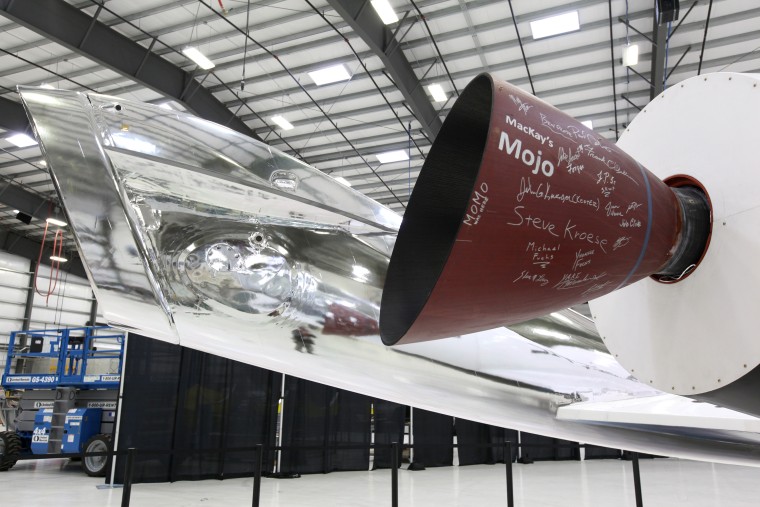MOJAVE, Calif. — Virgin Galactic's chief pilot, David Mackay, has been waiting years to take his first turn at the controls for a rocket-powered ride on SpaceShipTwo — and on Friday, the veteran aviator guided the plane higher than he had ever flown before. So how was the view?
"To be honest, I did not look out the window at apogee," the 56-year-old pilot told NBC News afterward. He was too busy behind the controls, testing the thruster system that will one day help him maneuver the craft in outer space.
Mackay has wanted to be an astronaut since he was a kid, growing up in Scotland. He's flown Harrier jump jets as a test pilot for the Royal Air Force, and jumbo jets as a commercial captain for Virgin Atlantic. In 2009, a door to the space frontier opened up when he was chosen to lead Virgin Galactic's cadre of pilots for SpaceShipTwo and its WhiteKnightTwo carrier plane.
As soon as this year, Mackay and other test pilots could earn their commercial astronaut wings by flying SpaceShipTwo beyond 100 kilometers (62 miles), the internationally accepted boundary of outer space. They could even begin flying passengers to that height within the year.
This week's test flight at California's Mojave Air and Space Port didn't go anywhere near that altitude. But it did set a SpaceShipTwo record by going up to 71,000 feet (13 miles, or 22 kilometers). That's also Mackay's personal best.
Even the altitude at which WhiteKnightTwo released the rocket plane for launch, 46,000 feet, is higher than commercial airliners ever fly. "It's a long way up there — the sky is already getting dark," Mackay said.

When the hybrid rocket engine lit up, Mackay compared the acceleration to the kick of a dragster on a race track. "The difference is, it just goes on and on and on," he said. "It's unrelenting. ... I compare it to a magic carpet ride, because it's smooth. But it's wild because of the acceleration."
Mackay estimated that he and his crewmate in the cockpit, Scaled Composites test pilot Mark Stucky, felt about 2.5 G's of force at the peak of the 20-second rocket blast. The G-forces are due to get even more intense during future spaceflights.
Virgin Galactic's passengers, who are paying as much as $250,000 for the experience, may be thinking about floating around in zero gravity or seeing the curving Earth beneath the black sky of space when they board SpaceShipTwo. But the way Mackay sees it, getting there is at least half the fun.
"The rocket ride up is going to be a big part of the experience. ... Part of the thrill for us is to see how other people will react to it," he said.
More about SpaceShipTwo:
- Success! SpaceShipTwo reaches new high
- Catch SpaceShipTwo's in-flight entertainment
- NBC News archive on Virgin Galactic
NBCUniversal has established a multi-platform partnership with Virgin Galactic to track the development of SpaceShipTwo and televise its inaugural commercial spaceflight.
Alan Boyle is NBCNews.com's science editor. Connect with the Cosmic Log community by "liking" the NBC News Science Facebook page, following @b0yle on Twitter and adding +Alan Boyle to your Google+ circles. You can also check out "The Case for Pluto," my book about the controversial dwarf planet and the search for new worlds.